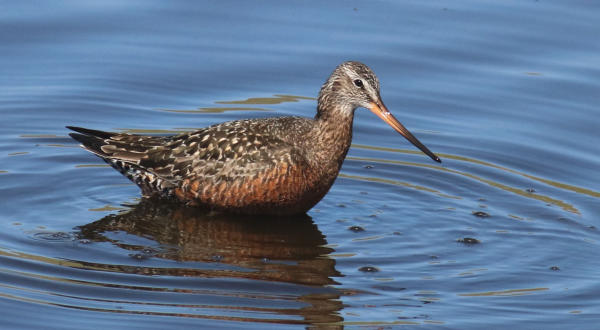
A male Hudsonian Godwit was photographed by Paul Konrad on its way from its wintering range in Argentina to a nesting territory in northern Canada, which emphasizes the importance of a hemispheric approach to shorebird conservation.
|
Most birders have heard of The Western Hemisphere Shorebird Reserve Network, but I wonder how many of us appreciate that this is one of the premier conservation efforts. The Western Hemisphere Shorebird Reserve Network is a system of internationally important sites used by shorebirds throughout their life cycles. The establishment of this network of shorebird sites is essential, because many of these species travel thousands or tens of thousands of miles annually from Arctic nesting sites to tropical wintering areas or temperate South American wintering sites. Without protection throughout their range, any conservation measures for individual species would be in vain.
Today, the Western Hemisphere Shorebird Reserve Network includes 104 sites representing 38 million acres of critical shorebird habitat in 16 countries across the Americas. That’s a tremendous accomplishment, but more important shorebird habitat remains to be protected in some way.
Recognizing that to simply designate a site isn’t enough to protect the birds, partnering groups and individuals work to educate the public about shorebirds and their needs to generate local support. Many Western Hemisphere Shorebird Reserve Sites are popular with birders and generate significant revenue for communities. But in some Caribbean and South American countries, legal and illegal hunting of shorebirds remain a concern, and partners work to enact or enforce laws to protect shorebirds.
Cutting-edge science, such as the use of satellite transmitters, is used to track shorebird species and better understand their needs during migration. Management plans are also developed to create ideal conditions that maximize foraging, nesting or resting requirements at specific sites.
There are also excellent cooperative plans to guide and coordinate conservation. The U.S. Shorebird Conservation Plan, for example, helps coordinate the efforts of dozens of government agencies and conservation partners who seek to keep our 50 species of shorebirds healthy for generations to come.
So what can we do? We can start by supporting the Western Hemisphere Shorebird Reserve Network financially. Look into some giving and sharing options. There may also be conservation groups working on shorebird conservation in your state. This isn’t just a coastal cause; shorebirds are found in all 50 states. These organizations need financial help and the expertise of volunteers.
Your political voice is also important; in fact, more important than ever. A personal note to elected officials expressing your support for protected areas and the economic and recreational value they provide is worth its weight in gold. If you consider the Endangered Species Act important, let your senators and representatives in Washington know so we avoid the extinction of another shorebird species, like the Eskimo Curlew. Half of North America’s shorebirds are declining, but coordinated, strategic and comprehensive conservation programs can help ensure that Red Knots, American Oystercatchers and Western Sandpipers don’t follow the path of Eskimo Curlews.
Conserving shorebirds requires an “all hands on deck” approach. The Western Hemisphere Shorebird Reserve Network is the “deck.” You and I are the “hands.” Please, support the ultra-important work?
For more information, take a good look at their website and contact the Western Hemisphere Shorebird Reserve Network at www.whsrn.org along with the U.S. Shorebird Conservation Plan’s website at www.shorebirdplan.org